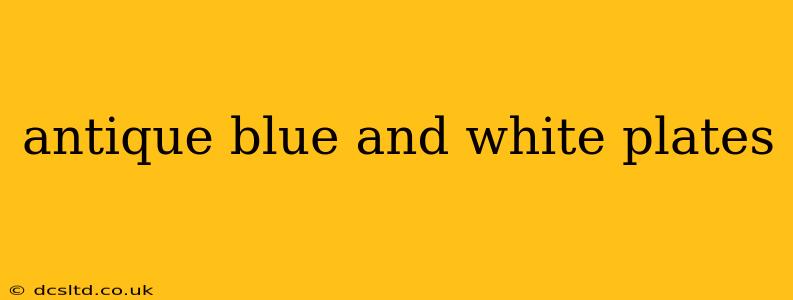Blue and white porcelain plates have captivated collectors for centuries, their timeless elegance and rich history making them highly sought-after items. From delicate floral patterns to bold geometric designs, the variations within this category are vast, offering something for every taste and budget. This guide delves into the world of antique blue and white plates, exploring their origins, identifying characteristics, and providing tips for discerning collectors.
What Makes Antique Blue and White Plates So Valuable?
The value of antique blue and white plates hinges on several factors. Rarity, of course, plays a significant role. Plates from specific kilns, periods, or with unique designs are more valuable than mass-produced pieces. The condition of the plate is also crucial; chips, cracks, and significant wear can dramatically reduce value. The artistry involved—the quality of the painting, the intricacy of the design, and the overall craftsmanship—all contribute to a plate's desirability and, consequently, its worth. Finally, provenance—a documented history of ownership—can significantly boost value for truly exceptional pieces.
How Can I Identify Antique Blue and White Plates?
Identifying antique blue and white plates requires a keen eye and some knowledge of porcelain history. Several clues can help:
- Markings: Look for maker's marks, often found on the back of the plate. These marks can pinpoint the origin and period of the piece. Researching these marks is crucial for accurate identification.
- Paint Style: The style of the blue paint can be indicative of age. Early pieces often feature a slightly less vibrant, more muted blue compared to later reproductions. Examine the brushstrokes; antique pieces often show more individual brushwork than mass-produced items.
- Glaze: The glaze itself can provide clues. Older pieces may show signs of crazing (tiny cracks in the glaze), which can be a characteristic of age and not necessarily a defect.
- Shape and Form: The shape of the plate and the form of the rim can offer clues. Certain shapes were popular during specific periods, assisting with dating.
What are Some Popular Styles of Antique Blue and White Plates?
Several styles of antique blue and white plates are highly collectible:
- Chinese Export Ware: These plates were produced in China specifically for export to Europe and the Americas. They often feature designs reflecting European tastes alongside traditional Chinese motifs.
- Delftware: Originating in Delft, Netherlands, Delftware plates feature a distinctive tin-glazed earthenware and characteristic blue and white designs.
- English Blue and White: English porcelain factories produced their own variations of blue and white plates, often incorporating designs inspired by Chinese or other European styles.
How Can I Tell if My Blue and White Plates are Genuine Antiques?
Determining authenticity is challenging and often requires expert assessment. Several steps can help you establish whether your plates are genuine:
- Professional Appraisal: Consult with an experienced appraiser specializing in antique porcelain. They possess the knowledge and tools to authenticate your pieces accurately.
- Research: Thoroughly research the markings and design styles. Compare your plates to known examples in books, auction catalogs, or online databases.
- Check for Inconsistencies: Examine your plates for signs of recent manufacturing. Inconsistencies in paint application, glaze, or the overall design can indicate reproductions.
Where Can I Find Antique Blue and White Plates?
Antique blue and white plates can be found in various places:
- Antique Shops and Dealers: Local antique shops and specialized dealers in porcelain are excellent resources.
- Auction Houses: Auction houses regularly feature antique porcelain in their sales.
- Online Marketplaces: Online marketplaces like eBay and Etsy offer a wide selection, but buyer beware; thorough research and caution are essential when purchasing online.
- Estate Sales: Estate sales can be a treasure trove for discovering unique and valuable antique plates.
How Much are Antique Blue and White Plates Worth?
The value of antique blue and white plates varies dramatically depending on the factors mentioned earlier. Common plates may be worth a few hundred dollars, while exceptionally rare and well-preserved pieces can fetch thousands or even tens of thousands of dollars at auction. Professional appraisal is always recommended for accurate valuation.
How Do I Care for My Antique Blue and White Plates?
Proper care is crucial to preserving the value and beauty of your antique blue and white plates:
- Handle with Care: Always handle plates gently to avoid chipping or scratching.
- Gentle Cleaning: Use a soft sponge or cloth and mild dish soap for cleaning. Avoid abrasive cleaners.
- Safe Storage: Store plates carefully, ideally individually wrapped in acid-free tissue paper, to prevent damage.
Collecting antique blue and white plates is a rewarding pursuit, offering the joy of owning beautiful historical objects and the thrill of the hunt. By carefully studying the characteristics of different styles and employing due diligence in your acquisition, you can build a valuable and cherished collection. Remember that professional appraisal is always a worthwhile investment when dealing with valuable antiques.
